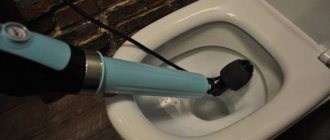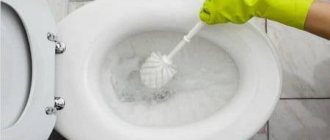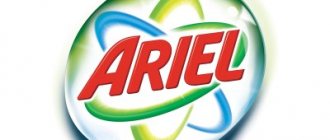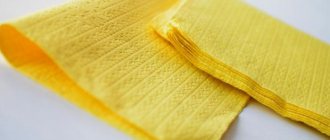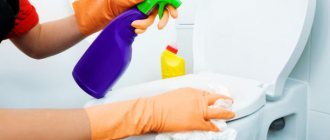When conventional toilet cleaning products don't help, you have to take drastic measures. I found a recipe on the Internet that I now recommend to all my friends. You need to mix washing powder and “Whiteness” and apply the slurry to the contaminated surface. Urine stone and all dirt will disappear without effort. But! There is a nuance that needs to be taken into account.
Toilet cleaning products
It is better to clean the toilet with chemicals. It is undesirable to use abrasive compounds and metal brushes. Such devices will remove plaque, but will leave abrasions and scratches on the ceramic. And in such areas, the next portion of lime and rust forms much faster.
Most toilet chemicals are strong, but are neutral to ceramics and enamel.
Folk
Thin deposits and small stains can be easily removed with standard household products. Mandatory condition for use: before cleaning, you must completely empty the toilet bowl of water.
- To clean the bowl, take a glass of 9% vinegar , heat it to 40 degrees and pour it into the drain hole so that a stream of liquid first washes the bowl. You can add a little salt. It is advisable to leave the toilet overnight and rinse it in the morning.
- Citric acid is used for the same purposes . 2 sachets are dissolved in a glass of water and poured into a bowl. Limescale deposits are dealt with faster by citric acid. If necessary, the procedure is repeated.
- of baking soda onto the stains and leave overnight. When reacting, soda does not form any toxic or dangerous emissions, so the method is completely safe. In the morning, the contaminated areas are wiped with a dry sponge, and then the plumbing is washed.
- Carbonated sweet water , like Sprite or Coca-Cola, copes well with contaminants The drink is poured over the bowl and served overnight. Wash it in the morning.
“Sprite” is convenient for cleaning the drain tank from lime and rust. Several liters of the drink are poured into the tank instead of water and washed several times in the morning. If the coating is thin, such cleaning can be done without disassembling the fittings.
the plastic seat is heavily soiled, clean it with soda : cover the areas and leave for several hours. You can also use citric acid, but in the form of a solution. Soak a sponge in it and wipe the rim and lid.
It is impossible to wash the plastic if the yellowing is long-standing. In extreme cases, abrasive agents may be used. They give an effect, but after such cleaning the plastic absorbs dirt faster.
Chemical
If the contamination is complex, the toilet is cleaned using strong chemicals.
- “Belizna” is a universal cleaning composition. “White” is poured into the toilet overnight and washed in the morning. The method is recommended for the deposition of urinary stones: “Whiteness” softens and partially dissolves thick plaque. The residues become more loose and can be easily removed with a wooden spatula or spatula.
- 5–7% phosphoric acid is used to clean heavy contaminants in a bowl, tank, siphon. Fill the toilet with the product, leave for 10–15 minutes, and then flush it off using a brush. The same procedure can be repeated with the drain tank. Phosphoric acid is allowed to be used in plastic sewer pipes.
- Battery fluid is a mixture of inorganic acids. The product is carefully poured onto the walls of the toilet from a vessel with a thin spout. Leave for 10–15 minutes and rinse with plenty of water. You can use electrolytes if there are metal sewer pipes.
You can work with acids only with the use of protective equipment: rubber gloves and a respirator.
Cleaning the toilet until it shines - recipe
As I already said, the method of cleaning the toilet with powder and “Whiteness” was not invented by me. I took it from a popular YouTube channel. I attach the video:
We recommend: How and with what to clean a bathtub from potassium permanganate?
How I prepared the cleaning product:
- I cut off the bottom of a 1.5 liter bottle.
- I poured 4 tablespoons of washing powder into it.
- I poured about 50 ml of “Whiteness”.
- Stir with a wooden stick. The result was a fairly liquid paste.
Now the important point. In order for the toilet to clean well and become snow-white, you need to scoop out all the water. You can use an empty bottle for this. Immerse the neck in water. Squeeze hard and release slowly. The bottle is filled with water. Pour the water into a bucket and repeat this several times.
Let's get back to the cleaning process. It's pretty simple. Active actions take 10 minutes at most. The rest of the time you just have to wait - I just managed to put things in order in the rooms.
So what to do next:
- Using a brush, apply the prepared product to stains, deposits or other contaminants in the toilet.
- Don't forget to treat the space under the rim. Rub lightly.
- Wait 1 hour. During this time, hard deposits soften and partially crack.
- Rub with a brush with a little more force so that the cleaning paste penetrates as deeply as possible.
- Again time 1 hour.
- When the waiting time comes to an end, heat the water in the kettle. The water should be hot, but not boiling. There shouldn't be a couple. Boiling water can cause faience to crack.
- Pour hot water into the toilet. 2 liters will be enough.
- Rub the walls with a brush. A foam is formed that will easily remove any remaining dirt.
- Press the drain button.
- Evaluate the results of cleaning the toilet with powder and “Whiteness”!
Tools for work
To clean the toilet, you need the simplest tools:
- brush;
- wooden spatula or rubber spatula;
- measuring cup with a thin spout;
- hard, but not metal sponges, soft rags.
You will also need rubber gloves and sometimes a respirator.
How to clean a toilet from rust, plaque and stone
There are different types of contaminants, each of which has its own cleaning method. But there are also universal methods that are also very effective. We offer a list of the most effective of them.
Cleaning with mustard powder
Act like this. Take two tablespoons of citric acid and mustard powder each, add four tablespoons of starch. Mix everything well. Fill with water until you get a paste. Moisten the bowl so that the mixture sticks. Apply the powder, spreading it evenly over the surface. Rub in the most contaminated areas. Leave on for an hour and a half, rinse off.
- Cleaning
5 ideas for using mustard powder at home
Treatment with vinegar and soda
Home remedies can also help deal with dirt. There is nothing difficult about cleaning with them. First, dampen the plumbing. Sprinkle baking soda evenly over its surface. In the most contaminated areas, rub the wet powder into the growths. Leave for half an hour to an hour. Pour table vinegar or diluted essence into a spray bottle and spray generously with soda. A reaction begins that destroys the dirt. You can “help” her with a brush. Once the reaction is complete, clean the bowl again with a brush. Rinse off any remaining product.
Toilet cleaning algorithm
The instructions for bleaching a toilet bowl are simple. When using different tools, the general algorithm remains the same.
- Water is scooped out of the bowl and collected in a bucket. Only a few special products suitable for cleaning bowls and sewer pipes are poured into standing water.
- Dry powders are poured into the hole and distributed over the surface of the bowl. Try to apply a thicker layer to problem areas.
- Liquid products are poured, but not into the drain, but onto the walls of the bowl. It is recommended to take a glass with a spout to pour the cleaning solution directly under the rim. Factory-made drugs are often equipped with bottles with special curved nozzles. They make it easier to effectively clean the area under the rim.
- The product must be left for the time specified in the instructions. Typically, 10–20 minutes are enough for cleaning gels. The powders are left for several hours. Folk weak remedies, like vinegar – for 10–12 hours.
- Wash off the remaining product and dissolved dirt, plaque and urinary stones with running water. Wipe the walls with a sponge or soft brush when rinsing to quickly remove residue. If the plaque is too thick, clean it off with a wooden spatula or spatula.
- If after the first procedure the result is unsatisfactory, repeat cleaning 1-2 times. They use the same product, do not combine different ones.
Cleaning the drain tank is done a little differently. If the deposit is small and the fittings are not damaged, pour washing liquid into the bottom of the container and rinse it after a few hours. If the contamination is complex, you need to remove the tank, remove and disassemble the fittings, and then wash each part separately.
Valera
The voice of the construction guru
Ask a Question
The drain column, lever, and float are left overnight in a container with a weak acidic or alkaline solution - vinegar, Sprite, or soda solution. After a few hours, the plaque completely dissolves or becomes loose. Residues can be easily removed with a rag, sponge, or spatula. The parts are then washed under running water and assembled.
Attention, nuance - precautions
“Whiteness” is an unsafe remedy in itself. You can easily inhale the caustic gas released, not to mention the liquid getting on your skin. It is strictly prohibited to combine it with other chemicals: a violent chemical reaction may occur. Washing powder is also prohibited. I found this out after trying the product. I didn't notice any negative effects. But I couldn’t help but mention the existing danger.
We recommend: How to effectively clean limescale from a shower head?
When using a paste of washing powder and “Whiteness”, you should take all precautions:
- Wear protective gloves and, if possible, a mask and goggles.
- Before cleaning, open doors and windows and turn on the hood.
- Do not lean over the cleaning agent or inhale the fumes.
- Mix the paste carefully, avoiding the formation of splashes.
- Leave the toilet immediately after treatment.
- After cleaning is completed, ventilate the room well.
If something goes wrong and you feel a burning sensation in your throat or shortness of breath, you need to go out into the fresh air and breathe deeply. You can also drink water or milk. If there is no improvement, you should call an ambulance. In case of contact with skin, the product should be washed off as quickly as possible with cool water. If a burning sensation is felt, it is necessary to lubricate the skin with ointment with panthenol or vegetable oil. If it worsens, it is better not to risk your health and consult a doctor.
How to keep your plumbing clean
The rules for preventing pollution are very simple.
- You should always flush the toilet after each use of the toilet.
- It is recommended to place water softening tablets in the cistern. They prevent salts from settling in the tank and bowl.
- Gel-like products are attached to the toilet rim. With each rinse, a small portion of the cleaner is released, which disinfects the surface and prevents the formation of urinary stones.
- Once a week it is recommended to treat the toilet with chlorine-containing compounds or bleach for disinfection.
- The seat and cover should be washed thoroughly every week with hot water and soap or detergent.
If there is a problem with the toilet, tank, or sewer system, you need to find the cause as quickly as possible and eliminate it.
Three main types of pollution
One of the common problems is limescale, which quickly appears on the surface of the bowl. Its growth rate depends on the composition of tap water. In most regions of Russia it is hard, with a large amount of mineral impurities. They are deposited on the surface, first in the form of small, inconspicuous crystals, and then as a grayish-brown rough mass.
The second problem is rust. It often occurs due to old age of the pipes. The fact is that decades ago utility lines were assembled from non-galvanized metal pipes. Over the years they have become rusty inside. Therefore, brown streaks appear on the surface of the plumbing fixtures. Rust can appear for other reasons. For example, due to a leaking flush tank or due to an excess of iron in tap water. In any case, rusty spots will appear on the bowl or reddish-brown streaks will appear.
And the last type of pollution is urinary stone. Outwardly, it resembles limescale, only the color is darker, more like brown. It is formed similarly to plaque, but from minerals contained in human urine. If it is not washed off well or the plumbing fixtures are not used carefully, crystals of urinary stone are gradually deposited on the surface. Over time, a dark, dense growth forms.
- Cleaning
6 killer products that will make the dirtiest bathroom sterile
Reasons for the problem
Limescale is formed as a result of the deposition of salts that are in the water. The harder the water that enters your home, the faster plaque will form. This sediment has a yellowish tint. It can be seen in flush areas and near the toilet rim.
In the absence of regular cleaning of the surface, a layer of lime will build up. The longer the cleaning is not carried out, the more difficult it is to remove the contamination.
Limescale is not limited to toilets; it can appear in sinks, showers and bathtubs .
Features of removing rust from a toilet at home
Corrosion on ceramics occurs as a result of metal oxidation. The source may be a central pipeline that is in poor condition. In this case, corrosive particles of non-galvanized pipes fall into the bowl and, when flushed, form rusty marks. Their appearance can be caused by rusted fasteners inside the tank, lack of proper care and high iron content in the water. The situation is worsened by unevenness and microcracks on the earthenware surface. As a result, yellow stains not only spoil the appearance of the closet, but also provoke the spread of microorganisms and unwanted odors. Before cleaning, you need to consider the main points:
- To clean the bowl, use soft sponges and brushes that do not damage the ceramic coating. The use of hard devices accelerates the formation of brownish plaque.
- Start the cleaning process when the first signs of yellowness appear on the earthenware. The darker the rust strip, the more difficult it is to remove.
- Before cleaning, remove excess water from the toilet with a ladle and wipe the toilet with a rag or paper towel. Cleaning products are much more effective if applied to a dry surface and remove plaque faster.
When using household chemicals, wear a protective mask and gloves on your face. Inhalation of harmful fumes and contact with skin may cause allergies or other health problems.
Household chemicals
Modern chemicals clean enameled plumbing fixtures from limescale, sediment, urinary stone, blackness and rust. To clean your bathroom, purchase the product in the household chemicals department or online, read the instructions for use and process according to safety precautions: wear rubber protective gloves and a respiratory mask to protect your respiratory tract.
Cleaning with Coca-Cola
It is easy to clean the bottom and thicket of the toilet bowl from urinary stones with Coca-Cola.
Cola cleans the toilet
Its components effectively corrode contaminants caught in the long-term contact zone. Therefore, many housewives buy this inexpensive drink for cleaning kettles and plumbing:
- Remove water by pushing it down the drain with sharp movements.
- Pour 1.5–2 liters. Coca-Cola into the toilet.
- After a couple of hours, wipe off the dissolved dirt with a toilet brush.
Given the liquid consistency of the drink, removing intense stains under the rim is almost impossible. Therefore, housewives use Coca-Cola as a preventive measure against urinary stones and limescale.
"Whiteness"
It’s easy to clean a toilet from streaks with “Beliznaya”, since chlorine resists many types of stains and stubborn dirt.
Whiteness d
The disadvantage of this product is the unpleasant odor, but it is inexpensive, so it is used by many housewives.
Using “Whiteness” to clean the toilet step by step:
- Remove as much water as possible from the toilet.
- Pour “Whiteness” onto a brush or contaminated enamel. To enhance the effect, add any product with a thick consistency for cleaning the toilet.
- Scrub the toilet bowl vigorously, paying special attention to problem areas.
- After 2-3 hours, clean with a brush and remove any remaining deposits with a non-metallic scraper.
Note ! When cleaning severe limescale deposits, you can use an old blade. Scrub gently with it and the loose deposits will come off, but be careful not to scratch the enamel.
Hydrochloric acid
When using this product, be sure to follow safety rules so as not to damage your skin and lungs! Pour hydrochloric acid over the toilet bowl, scrub with a brush and close the lid. After 15–20 minutes, scrub the stains again and rinse off the acid. Do not use the product if the drain is made of plastic pipes.
Automotive electrolyte
Electrolyte for cars helps against stone, corrosion and plaque, returning the bathroom to its original whiteness and shine.
Electrolyte will wash away impurities
Additionally, the product will clear the sewer from blockages and eliminate red rusty streams. The processing principle is the same as that of hydrochloric acid, but use this method as little as possible so as not to damage the enamel.
Note ! Also, to clean plumbing fixtures, use special products, for example, Silit or toilet duck, and avoid powders and abrasives that can scratch the enamel. The damaged coating is further exposed to lime deposits.
Where does rust in water come from?
Source remont-book.com
I hope you understand that rust gets on the walls of the toilet along with the water you regularly flush the plumbing fixture with. But here another question may arise: how does this result of metal oxidation get into the water? In fact, everything is simple: main pipelines are rarely made of galvanized metals, and an ordinary pipe, due to the combination of exposure to water and oxygen, becomes corroded from the inside. It is this that is washed away by the water that is distributed among the apartments. Another reason for rust getting into the water you flush the toilet with can be rusty mounting bolts on the flush tank of the plumbing fixture.
